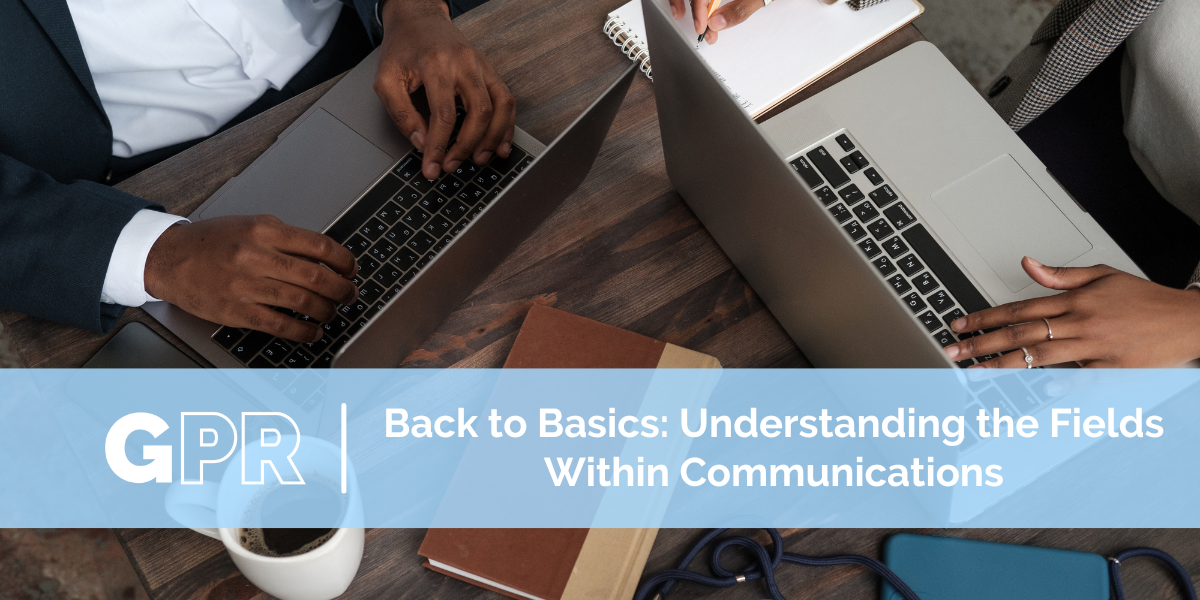Back to Basics: Understanding the Fields Within Communications
In communications, it’s easy to treat every term like it means the same thing. People often use advertising, marketing, and public relations (PR) interchangeably, but each has its own focus and purpose. As PR students and future professionals, it’s important to understand where these areas overlap and where they don’t. Knowing the difference helps you collaborate better, communicate clearly, and build stronger strategies.
Communications
Communications is the umbrella term that ties everything together. Communications looks at how messages are shared both inside and outside an organization. It includes everything from how a company talks with its employees to how it connects with the public. Whether that’s through social media, a news release, or an ad campaign, communication’s goal is always connection. Every branch underneath it just takes a different path to reach that goal.
Public Relations
Public relations is about managing reputation and building trust. It focuses on the long-term relationship between an organization and its audience. Instead of paying for attention, PR earns it through media coverage, storytelling, and community engagement. A well-placed article, a thought-out event, or a meaningful social media campaign can all build credibility that money can’t buy.
For students, that means paying attention to how stories are told and how messages make people feel. PR isn’t just about visibility, it’s about shaping perception.
Advertising
Advertising is paid. You buy the space or time and get control over exactly what people see. That means you can make your message look and sound the way you want, and you can reach a lot of people quickly. Ads are all around us, from billboards and social media to television and beyond, and they work because they put the message right where people can see it.
But advertising isn’t a magic fix. Even though you control the content, people know it’s paid for and often view it with skepticism. It can be expensive, especially if you’re trying to reach a large audience or compete in a crowded market. Ads also have a short shelf life — once they’re done running, they’re typically gone. And they don’t automatically build trust or credibility; that usually comes from PR efforts.
In reality, advertising works best when it’s part of a bigger strategy. It’s great for boosting awareness, highlighting promotions, or supporting a product launch, but on its own, it doesn’t guarantee that people will believe or care about your message.
Marketing
Marketing is the strategy behind everything. It looks at the bigger picture — what the brand wants to achieve, who it wants to reach, and how to measure success. Marketing connects all the pieces of communication: PR for credibility, advertising for reach, and social media for engagement.
If PR builds trust and advertising builds awareness, marketing ties them together to create results. For students, understanding marketing helps you see how your PR work fits into the larger strategy.
Social Media
Social media sits at the intersection of it all. One post can be PR, advertising, or marketing, depending on its purpose. A paid partnership is advertising. A story highlighting a company’s impact is PR. A data-driven content calendar built to grow an audience is marketing.
The key is remembering that social media is a channel, not a strategy on its own. It’s a tool for delivering messages, connecting with audiences, and measuring impact, but the intention behind each post determines which part of communications it serves. For students learning the field, that means thinking critically about every post: Why are you posting this? Who are you trying to reach? What’s the goal? The platform is just where it happens, but the strategy and purpose give it relevance.
Why It All Matters
Understanding these differences helps you work smarter, no matter what field you go into. In group projects or professional settings, you’ll often collaborate with people across these areas, from PR teams to communication specialists. Knowing the goals and responsibilities of each field makes collaborative work much more effective and rewarding. It also builds credibility. When you can explain why a client needs PR instead of advertising, or how marketing supports both, you’re thinking like a professional.
All of these areas serve a common purpose, but they do it in very different ways. When you understand what makes PR, advertising, marketing, and communications unique, you can make smarter choices about how to craft and share your messages. That understanding is what turns a good idea into one that actually connects with people.
Meet Kristina
Kristina is a senior majoring in Advertising and Public Relations, serving as the CEO of GrandPR, which is directly affiliated with GVPRSSA. She is most excited to see the incredible work the GrandPR client teams will produce this year and to support them in advancing their skill sets. After graduation, Kristina plans to take a year to study for the LSAT before attending law school, aiming to combine her passion for strategic communication and advocacy in her future career.


